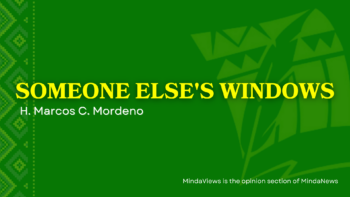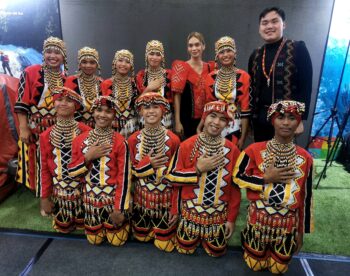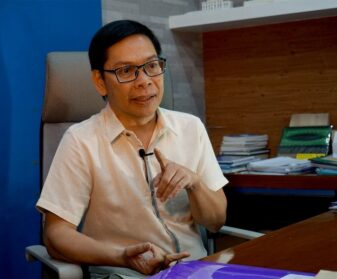DAVAO CITY (MindaNews / 17 Feb) — Since EDSA I, as a way to acknowledge the major contribution of concerned artists in dismantling the Marcos dictatorship, February – when the EDSA event is commemorated – is also the country’s Arts’ Month.
The National Commission of Culture and the Arts (NCCA) has been tasked to organize activities across the country to make sure there are meaningful cultural activities that contribute to nation-building. This year, the NCCA’s launching of the celebratory event is held in Bago City. Across the country, various academic, cultural and governmental institutions are supposed to get into the bandwagon.
Alas – except for a few initiatives of some colleges and universities – nothing is heard about cultural events being organized in the first half of the month. Public officials of our local government units (LGUs), caught in the feverish momentum of getting ready for the May 2019 elections, are spending all their money in assuring their or their dynasties’ perpetuity in government. Those locations nearest Jolo are still reeling from the impact of the bombing of the cathedral. Martial law’s persistence in Mindanao dampens the creativity of the citizens. Concerned artists have practically disappeared from the cultural landscape and except for visual artists, eruptions of creative productions have been few and far between. And being in the periphery of this nation, Mindanao’s share in the budget of the country’s culture and arts institutions remains limited.
The only reason why we have not become a cultural desert with nothing to manifest the richness of the Mindanawon culture which arose out of our descendants’ creative spirit is the fact that among ordinary people, there are still artists who persist in creating works of beauty. Usually referred to pejoratively as “folk artists” and their works being labeled as “crafts,” they are truly the people’s artists. And their works – ranging from handwoven cloth to musical instruments, from gold jewelry to intricate baskets, can easily find their way into museums or the more preferred name by the Lumads as Centers for Living Traditions.
There are also the localized festivals mainly celebrating an attempt of LGUs to promote tourism. Because they do engage the local barangays and schools, are provided budgetary allocations that can pay the services of local creative artists as well as give out cash rewards, these events have showcased grassroots artistic creativity. While the high-brow cultural watchdogs may look down on these productions as kitsch and the purists among them insist on “the authentic indigenous expressions,” one cannot just ignore their role in making sure arts and culture in this country persist as elitist domains. As for the kind of arts and culture that thrived during the Marcos era which encompassed all forms — from poetry to theatrical productions, song-writing to film-making, social realistic visual arts to street performances at rallies — these have become as rare as our primal forests. These were watershed cultural productions because they were nationalist in orientation, grassroots-based, provocative in terms of consciousness-raising, promoting true creativity and which captured the people’s soul.
Alas, in the millennial generation’s era, this watershed turned into a desert. Between the eruption of People Power at EDSA in 1986 and the age of Dutertismo, global and local realities evolved into a new set of socio-eco, political and cultural realities. Globalization brought about paradigm shifts; the internet technology and the proliferation of high-tech gadgets changed the manner people inter-acted with each other. This has been especially true for the children – and now the grandchildren – of the activist generation who fought the forces of oppression in the streets in the 1960s – 1980s. Did anyone of us who were caught in the life-death struggles of the Marcos repressive years and experienced the euphoria of the dictator’s downfall imagine that only a generation later, their hidden wealth (never recovered) and the power of trolls and fake news would bring the dictator’s children back in the corridors of power?
The realm of culture played a major role in helping people understand the roots of our enslavement and the way to emancipation which was why that movement to end the Marcos martial law gained momentum. Concerned artists — filmmakers, theatre and visual artists, songwriters and writers — risked their lives along with peasants, workers and urban poor communities. In the process, their artistic output combined aesthetics and politics. They engaged art not to make a name for themselves, or for profit through corporate sponsorships. No wonder artists then found themselves fully inspired to create a whole range of innovative endeavors. Despite limited funds and under the fear of being arrested and salvaged, there was no let-up in terms of artistic output.
William Wordsworth’s words from his poem seem appropriate at this stage: “Though nothing can bring back the hour of splendor in the grass, of glory in the flower, We will grieve not, rather find Strength in what remains behind.”
What is past is past; we must confront what is the present and face the future with defiant hope.
One thing seems certain at this stage. We cannot just sit back and wallow in the memories of the yesteryears no matter if we believed we had great potentials then. We can no longer rely on the tools of social analysis we used in the 1960s-1980s. We can no longer appropriate the same kind of strategies and approaches in initiating a social movement. And we need to put our trust on the present generations; and if they so desire it, pass on to them some lessons of the past which may still have a value today. But it is not for our generation to decide on that matter.
Who knows, once we can get our act together, someone might come up with a song that we can all sing which can lift our spirit once again.
I end with a tribute to Tita Ayala, invoking her spirit to empower us today:
most of your life, Tita
you walked the road less travelled
at a time when trails were muddy
leading nowhere but fields of thorny grass.
what images did you glimpse, Tita
as you gazed at maps showing crossings
so that a blank page of paper
can be transformed to a parchment of meanings?
did you find companions, Tita
as you journeyed down those roads
to help carry your burdens
of keeping story-telling traditions intact?
before you departed, Tita
were you filled with hope that somehow
traditions are kept intact as new poets
& prophets arise out of our barren land?
(MindaViews is the opinion section of MindaNews. Redemptorist Brother Karl Gaspar is a professor teaching at St. Alphonsus Theological and Mission Institute (SATMI) in Davao City and the Ateneo de Davao University. Gaspar is author of several books, including “Desperately Seeking God’s Saving Action: Yolanda Survivors’ Hope Beyond Heartbreaking Lamentations” and two books on Davao history launched in December 2015. His recent book, ORDINARY LIVES, LIVED EXTRAORDINARILY – MINDANAWON PROFILES, was launched at the Ateneo de Davao University on February 8, 2019. He writes this column for MindaNews).







